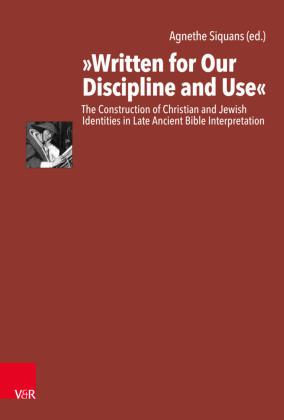
"Written for Our Discipline and Use" - The Construction of Christian and Jewish Identities in Late Ancient Bible Interpretation
| Verlag | Vandenhoeck & Ruprecht |
| Auflage | 2021 |
| Seiten | 205 |
| Format | 15,5 x 0,1 x 23,0 cm |
| Gewicht | 489 g |
| Artikeltyp | Englisches Buch |
| Reihe | Antike Schriftauslegung/Ancient Scriptural Interpretation Band 001 |
| ISBN-10 | 3525522193 |
| EAN | 9783525522196 |
| Bestell-Nr | 52552219A |
The contributions illuminate the reception of biblical texts, themes and figures in patristic and rabbinic writings from the 2nd to the 8th century. They reveal processes of mutual demarcation, which are sometimes extremely polemical, sometimes only implicit and indirectly accessible. The correct interpretation of Scripture is claimed for one's own "we", while at the same time distinguishing it from the "others". Nevertheless, similarities and mutual positive references are clearly recognizable. Especially the often so polemical Christian interpretation is from the beginning rooted in the Jewish tradition and based on it. But also the rabbinic interpretation shows traces of the controversy with Christianity.
In Christian and Jewish Bible interpretation in late antiquity, polemics and demarcation are evident, as are similarities and mutual references.
Patristic and rabbinic biblical interpretations are significant contributions to the identity construction of late antique Christian and Jewish groups. The contributions in this conference volume illuminate the reception of biblical texts, themes and figures in patristic and rabbinic writings from the 2nd to the 8th century. They reveal processes of mutual demarcation, which are sometimes extremely polemical, sometimes only implicit and indirectly accessible. The correct interpretation of Scripture is claimed for one's own "we", while at the same time distinguishing it from the "others". Nevertheless, similarities and mutual positive references are clearly recognizable. Especially the often so polemical Christian interpretation is from the beginning rooted in the Jewish tradition and based on it. But also the rabbinic interpretation shows traces of the controversy with Christianity.
In Christian and Jewish Bible interpretation in late antiquity, polemics and demarcation are evident, as are similarities and mutual references.
Patristic and rabbinic biblical interpretations are significant contributions to the identity construction of late antique Christian and Jewish groups. The contributions in this conference volume illuminate the reception of biblical texts, themes and figures in patristic and rabbinic writings from the 2nd to the 8th century. They reveal processes of mutual demarcation, which are sometimes extremely polemical, sometimes only implicit and indirectly accessible. The correct interpretation of Scripture is claimed for one's own "we", while at the same time distinguishing it from the "others". Nevertheless, similarities and mutual positive references are clearly recognizable. Especially the often so polemical Christian interpretation is from the beginning rooted in the Jewish tradition and based on it. But also the rabbinic interpretation shows traces of the controversy with Christianity.
